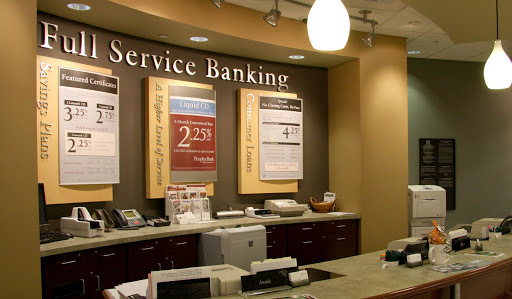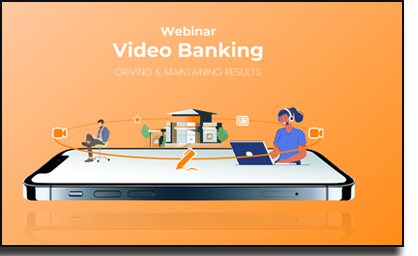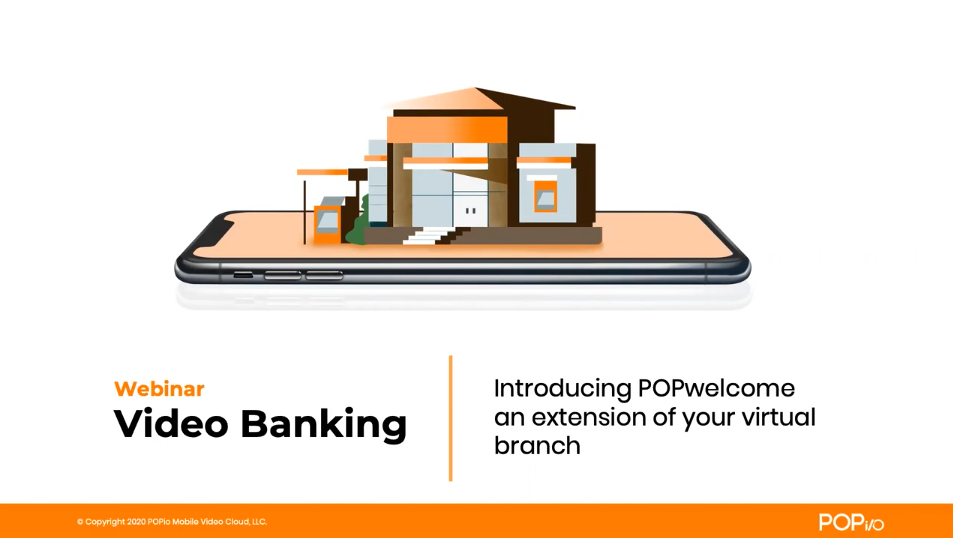POPwelcome is the best way to engage with your consumer through the digital channel of their choice, chat, voice, or video. Customer Service Representatives can then answer questions, co-browse webpages, and seamlessly transition the call to voice or video to elaborate on available products and services. See a demonstration and learn how this new feature can help you.
For more information about video banking, request a free demonstration.

 Remember back before the pandemic, when traditional financial institutions’ greatest concern was relevance? Today with Covid-19 concerns, FI executives are consumed by the need to deliver touchless service while managing new concerns about employee safety, dwindling earnings, loan losses, and capital.
Remember back before the pandemic, when traditional financial institutions’ greatest concern was relevance? Today with Covid-19 concerns, FI executives are consumed by the need to deliver touchless service while managing new concerns about employee safety, dwindling earnings, loan losses, and capital.
As a result, relevance has moved down on the priority list. While relevance may not be an immediate priority, the need for it remains high. Consumers understand or perhaps don’t care if an organization struggles with financial or regulatory concerns, they just want a relevant provider to serve their needs.
InRoads Credit Union is a $288 million community-chartered institution headquartered in St. Helens, Ore., a town of approximately 13,000 people. In St. Helens, $288 million in assets buys a lot more relevance than in nearby Portland. Still, President/CEO Brooke Van Vleet, who began her credit union career in the marketing discipline, recognizes the value of continuing to evolve that strong brand with the times. She and the InRoads team knew the credit union needed to continue investment into their digital services to remain relevant in their marketplace and ensure a sustainable future.
In 2019, InRoads went all-in on ITM drive-thru service for teller services and POPi/o’s Video Banking solutions for both mobile and in-branch video consultations. The goal was to provide members with a combination of digital convenience and face-to-face service to meet member’s needs. In the very early stages, members’ response to the new technology was lukewarm, that is until COVID-19 shuttered the community and InRoads closed all of its branches. Suddenly, video became the only way to get face-to-face service and adoption quickly grew four times over.

Preston recalled another member who refused to use video banking, loudly demanding that he sit across the table from a live human being. A branch employee eventually convinced him to just give the service a try. As he emerged from the video banking office and headed for the lobby door, the teller said, “Bye, see you later!” “No you won’t,” he said, “I’m using this from now on.” And just like that, InRoads gained relevance from a member who was perfectly happy with the status quo.
Chief Experience Officer, Ron Winter, explained that rolling out new technology and asking a small town community to adopt it isn’t always well-received. However, when the pandemic hit and InRoads already had a solution that was not only safe, but also maintained face-to-face service, perception of the credit union shifted in Columbia County. InRoads became the most relevant game in town. “It certainly positions us differently than six months ago,” Winter said. Video banking was a perfect complement to the new branding initiative the credit union began in 2018, in conjunction with its name change. In fact, video banking has become a cornerstone of how InRoads plans to serve members in the future. “We’ve talked a lot about what traditional used to mean, and I don’t think we’ll ever build another branch the way we used to,” he said. “Yes, we will have brick and mortar, but it will be different. Video banking will allow members to speak with a subject matter expert from anywhere. Even if you visit a small location, we can connect you to a commercial mortgage loan officer or whomever you need. That’s the vision.”
To learn how POPi/o Video Banking can help your financial institutions maintain relevance and personal service, request a FREE demo.

 Digital service providers are reporting explosive increases in user data over the past two months as shelter-in-place orders have forced consumers to go digital. Attitudes toward digital have seemingly changed overnight – what was once a user experience enhancement is now literally an essential service channel.
Digital service providers are reporting explosive increases in user data over the past two months as shelter-in-place orders have forced consumers to go digital. Attitudes toward digital have seemingly changed overnight – what was once a user experience enhancement is now literally an essential service channel.
The term disruption had run its course before COVID-19, but this largely unexpected even is just that, a major disruption for nearly every sector. Now that we’re about three months into this global pandemic, financial institutions are no longer wondering if, but how much COVID-19 will change the way they deliver products and services.
The answer could mean shuttering even more branches and once again rethinking branch strategy. Consider this: increased digital adoption won’t be the only drain on branch traffic. Experts say the stay-at-home environment could be a way of life for a long time. Certain groups of people, including retirees, those with compromised immune systems, and those fearful of infectious disease may forever avoid in-person interactions.
There’s more. Experts say social distancing could be required by authorities well beyond 2020.
As long as someone in the world has COVID-19 and there is no vaccine or herd immunity, breakouts can and will keep recurring without stringent controls, wrote MIT Technology Review Editor-in-Chief Gideon Lichfield. Even if social distancing measures are only put into place every time ICU admissions begin to spike, research models predict that strategy would still require a schedule of roughly two months under quarantine and one-off.
Harvard disease experts agree, saying that some form of intermittent social distancing may need to be in place until 2022 and possibly longer.
Social distancing is beginning to be referred to as physical distancing, which is a more accurate description. Despite being physically separated by quarantine, people have still found ways to be social. Neighbors have entertained each other around the world with balcony musical performances. Friends and family have honored graduates and birthdays with car parades. We’ve turned video conferencing into virtual happy hours that even have their own signature drink, the Quarantini.
Those under COVID-19 quarantine have shown that while they are willing to adhere to physical distancing, they still require face-to-face contact, even if it’s via video. To maintain brand loyalty, financial institutions will need to find ways to provide that level of human service. Many of them will have to find ways to make branching work despite the challenges, which will likely include the need to keep everyone at least six feet away from each other, limiting people in the branch at one time and increased personal hygiene and cleaning standards.
The solution lies in using technology in new, creative ways to provide meaningful social interaction, just as parents have created virtual graduation and birthday parties for their children. We’ve seen credit unions and banks integrate video banking like POPi/o into their branches in creative ways that provide a superior user experience while also supporting the institution’s bottom line.
For example, one financial institution completely centralized its lending operations, even going as far as to restructure branch employee incentives to guarantee their support of video banking in lending. To ensure privacy, an office in each branch was reserved exclusively for video banking sessions. This institution already had a pandemic-friendly branch strategy that minimizes employee exposure and maintains excellent physical distancing between two groups of customers: those completing transactions and borrowers.
Another video banking institution has closed its branches to walk-up traffic, performing only select services for customers by appointment only. However, it had already installed personal video teller machines outside of the lobby, providing an on-demand way to accept check and cash deposits, make cash withdrawals, and, if needed, connect to a live video teller who can perform more robust transactions and problem-solving. Time will tell if this strategy will work long term, but because video tellers had already been integrated into the branch strategy – even if only intended to extend service hours, not perform essential services during a national emergency – this financial institution didn’t skip a beat providing full branch service while being a good corporate citizen.
Are you frustrated with what seems like no-win options to adjust your branching strategy to physical distancing and other measures that will keep your employees and customers safe? Let POPi/o help you brainstorm ways your financial institution can use video banking to quickly and effectively meet the needs of your customers and your bottom line.


Throughout history, major events have created permanent, unexpected shifts in human behavior. People have been forced into lockdown to stop the spread of disease before; the long-term psychological effects of those quarantines have been studied, so we have some idea of what to expect. However, the length and global reach of this isolation are unmatched, and there is no doubt this traumatic event will produce permanent changes.
Here are three impacts of COVID-19 and their respective long-term outcome for community banks and credit unions.
Fear of public gatherings
After this pandemic has long passed, a generational shift will produce new preferences when it comes to public gatherings and face-to-face interactions. Following previous outbreaks in Asia, face masks became a normal and expected day-to-day accessory. With the fear of contagions and mandatory stay-at-home orders, people are becoming more comfortable replacing physical interactions with digital visits. The long-term shift will come as many start preferring it as a way to manage lingering fears of contracting a fatal disease. Perhaps you’ve already seen this fear play out on social media in emotional debates about whether or not a COVID-19 vaccine is required before reinstating sporting events, concerts, and other large public gatherings. In particular, subsets of the general population who are concerned about germs will be more sensitive to the risks involved.
The effect on FIs: Traffic at branches has been decreasing for years; however, fear combined with increased digital channel adoption will send this trend into overdrive. After all, it’s mostly older consumers who still use branches, and this age group will be understandably shaken by losing friends to COVID-19. However, older generations also value face-to-face service and prefer doing business with specific employees. Not only will video banking fill that service gap for this market, but adoption will also be easier than ever because so many grandparents have been using video to communicate with family during the quarantine.
We’ve said for years that consumers want to choose how they engage with their FI. If they can do it all digitally, more power to them. But in tumultuous times like now, people need more help from real people. Maybe they can’t pay their existing monthly loan payment due to reduced hours. Do they refinance the existing loan? Roll it into a HELOC? Find another solution? To solve this problem, they need a financial counselor, and that’s something credit unions and community banks can and should offer. Video banking supports that consultative relationship while still protecting the consumer and employees.
Economic shifts
I’m confident that the stock market and U.S. economy will survive and continue to lead the world; however, segments of the economy already affected by quarantine orders may not completely recover. Small restaurants, travel industries, commercial real estate, and auto industries are all likely to face a protracted slowdown.
The effect on FIs: Financial institutions that serve these industries will suffer resultant impacts on their businesses as well. Although markets shift and change every day, this change is so drastic and unexpected, we may see some financial institutions fail or merge for survival similar to the mortgage meltdown in the late 2000s. Those looking to thrive must find ways to economically provide their services. Again, we see video banking as a possible solution for cost-conscious service delivery.
Work from home
Now that a majority of U.S. workers are gaining remote work experience, a return to the office will be a tough sell. Let’s start with the dress code: sales figures from Walmart that report the chain selling out of tops but not pants. Americans have happily embraced new workplace standards that only require professionalism from the waist up and allow for interruptions from children during meetings.
The effect on FIs: Like everyone else in America, financial services employees will want to continue to work from home. Working from home and the schedule flexibility it will bring could create the need for, and ability to offer, longer service hours. While that might be possible from a technology standpoint, security will be an issue for FIs, because video conferencing apps like Zoom they weren’t built to handle secure financial information and workflows. We’ve helped our customers use the POPi/o platform to not only serve customers securely but also support employees who must now work from home and handle sensitive consumer information.
Change isn’t easy for anyone. Big external events (like a global pandemic) create new circumstances and could be the stimulus for permanent change. Good luck to you and your financial institution as you navigate the new normal post-Covid-19.

POPi/o Covid-19 Response

As I write this, the coronavirus death toll in the U.S. has risen to 6,574, and that number is sure to rise by the time you are reading this. Every state in the union has announced positive cases of Covid-19 and most have declared mandatory shelter in place orders. The financial markets have continued to tumble throughout the month of March and the Federal Reserve Board announced its first emergency rate cut since the 2008 financial crisis.
The fatality rate for Covid-19 isn’t as high as other viruses, but what seems to make Covid-19 frightening is how contagious it seems to be. Evidence that Covid-19 is more contagious than estimated lies in the numbers: the virus has reached 210 countries on six continents in a matter of weeks, and many of the infected report no contact with anyone known to be exposed to the virus.
At a time like this, how does a Financial Institution protect their staff and consumers? Most FI’s are choosing to close branches. During the month of March, I talked to hundreds of FI’s. In those meetings, I learned that most branch lobbies remained open on March 16th, but by the end of that week and early into the following week, the majority of branch lobbies had closed or restricted their access.
With this restricted access to physical locations, how can FI’s maintain business continuity? Amid the fear, there is some positive news: today’s technology allows financial institutions to provide essential services much easier than during previous pandemics. During the SARS outbreak of 2002, when most financial institutions last updated their business continuity plans, customers utilized call centers, ATMs and online banking services. These days, technology has enabled several additional tools such as mobile banking, mobile check deposit, video teller machines (ITMs), and video banking tools.
This transition to new technologies is happening already. Within 10 days of Covid-19 hitting the U.S. shores, our video banking company, POPi/o, saw video call volume jump 50%. We also saw a rapid shift from our in-branch video call volume to mobile and web video calls. Other financial services providers report digital channel traffic over the last few months to be equal to traffic during all of 2019. We expect traffic to continue growing.
During this pandemic, consumers need access to your FI resources more now than ever. Whether they need to discuss loan modifications or to apply for the government’s payroll protection program, consumer needs are just as high as their anxieties. Video Banking tools can assist financial institutions when they are forced to close branches, or when consumers are unable to leave their homes. FI’s can now deliver teller services from Interactive Teller Machines and with POPi/o Video Banking offer in-depth banking consultations and account services. Today’s Video banking is far more robust than basic communication via phone or video conferencing and allows for new accounts, loan origination, funding new accounts, exchanging documents, signing applications, and any number of account servicing needs.
Before today’s recent events, many of our credit union and bank clients have found POPi/o video banking to be useful in assisting customers who are homebound due to age, illness or disability. Others used it to assist professionals in medical, military or other circumstances that didn’t allow for quick trips to a branch. Now we see personal branch services being delivered to consumers in self-isolation, oftentimes with the staff member safely working from home.
If your credit union or bank is reviewing their business continuity plan and looking for additional ways to provide essential services using digital channels, request a demonstration or give us a call. We’d be glad to discuss how video banking can become an integral part of pandemic mitigation that protects your staff and consumers. Until then, stay safe, and healthy.

Can’t we just use Skype?
What’s the difference between video conferencing and video banking? Can’t you just use Skype, FaceTime or Zoom to talk to consumers with less overhead?
If you’re in charge of operations and want to add video banking to your FI’s digital channels, you might get these questions from your boss, executive team or board. There are very distinct differences between video conferencing and video banking, and in order to deliver the experience your consumers expect and maintain your service standards, you definitely need to offer video banking.
However, if you’re not prepared for the question and caught off guard you might struggle to explain the differences, so here’s a quick rundown of the facts.

Video Conferencing
Video communication apps allow two people in different locations to communicate face to face. As 3G and 4G technology availability has made connection faster and cheaper, video chat has become very popular across generations. Video conferencing is more than a Skype chat with Grandma. It also provides the ability to share educational information and provide a platform for business negotiations.
That’s one of the big differences between video conferencing and video banking – the former enables communication between businesses and is not addressing the consumer side of collaboration. Additionally, most video conferencing platforms require both parties to set a date and time to communicate, which creates service friction. How many times have you been the only one to show up for a video conference? It’s incredibly frustrating; imagine experiencing that as a consumer.
Video chat apps aren’t secure enough for banking transactions. You’ve probably heard the recent news about the iPhone FaceTime bug that allows users to eavesdrop on others before they even accept the call. The last thing your FI needs is bad publicity suggesting you don’t properly safeguard financial information because you used FaceTime to conduct financial transactions.
Finally, video conferencing’s main purpose is cost savings. It means you don’t have to fly your vendor or your remote team members into the main office for an in-person meeting. Free or low-cost video conferencing services might be cheaper than video banking, but when it comes to digital channels, cost savings isn’t the only factor to consider. Convenience, consumer experience, compliance, and workflow must be included in your due diligence.
Video Banking
Video banking, on the other hand, does more than allow face-to-face digital communication. It recreates an entire branch experience, with tellers, consumer service representatives, loan officers, and financial advisors.
That’s the biggest difference between the two channels – video banking was custom built to meet the needs of banking consumer needs and work with banking workflows. Unlike video conferencing, video banking usually includes the following features:
- Document collection
- Document signature
- Screen sharing
- Presentations
- URL sharing
- Standardized business workflows
- Branch, web, and mobile deployments
A robust video banking app brings all of your products and services together, which increases your staff efficiency and racks up sales.
Unlike video conferencing, which requires everyone to show up at a specific date and time, video banking can be built into your call center queue. That makes it on demand for consumers, the way retail channels should be.
Video banking also allows you to record the call, produce logs and metrics to track performance and provide data to prove compliance. That’s important: video banking apps are compliant with security regulations that safeguard financial data. WebEx and FaceTime are great services, but they aren’t going to impress your executive team.
Financial regulators are expected to scrutinize technology even more in 2019, according to a recent American Banker article. It reported that because Democrats have regained control of the House, and Republicans only hold a slim majority in the Senate, banking regulation is expected to tighten. Additionally, banking regulators are still under pressure to protect consumers from data breaches. You should expect your examiner to review all of your fintech vendors and digital channels, searching for weak links. Now is not the time to skimp on security!
Finally, consumers value experience more than ever. In fact, surveys keep revealing that younger consumers are willing to pay more for a loan if the lender provides a superior digital experience. Even Grandma, who already knows how to use video chat technology, appreciates the convenience video banking provides – many banks and credit unions have found that video banking adoption rates across all generations have been higher than expected.
The differences between video conferencing and video banking are clear. Start providing better experiences, that will make your financial institution one your consumers love.
Tracey Miller, VP of Branch Operations Pioneer Federal Credit Union, and Gene Pranger, inventor of video banking, discuss the adoption of video banking within Pioneer Federal Credit Union membership.
Tracey Miller, VP of Branch Operations Pioneer Federal Credit Union, shows a demo of the myPioneer Personal Assistant App powered by POPi/o Video Banking.
Tracey Miller, VP of Branch Operations Pioneer Federal Credit Union, shows a marketing piece for the myPioneer Personal Assistant.
Tracey Miller, VP of Branch Operations Pioneer Federal Credit Union, and Gene Pranger, inventor of video banking, discuss how POPi/o creates workflows that match current credit union processes.
Full interview with Luke Campbell VP of Sales & Service from Southwest Financial Federal Credit Union.
Scott Fieber, VP Strategic Solutions, at Cook Security Group and Gene Pranger, inventor of video banking, discuss why financial service provides should be considering ITMs.






